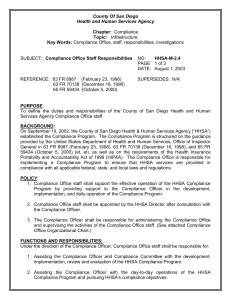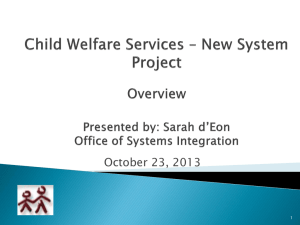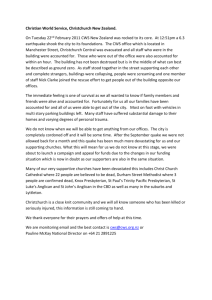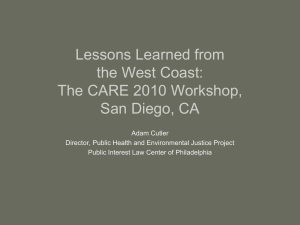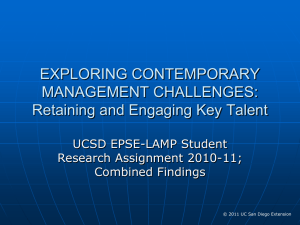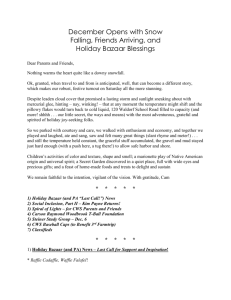Teaming Standards (04-174)
advertisement
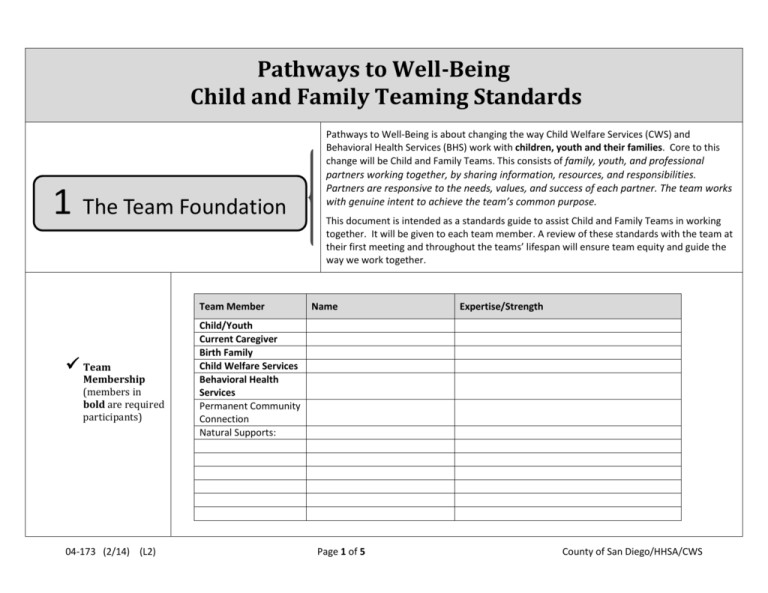
Pathways to Well-Being Child and Family Teaming Standards 1 The Team Foundation Team Member Team Membership (members in bold are required participants) 04-173 (2/14) (L2) Pathways to Well-Being is about changing the way Child Welfare Services (CWS) and Behavioral Health Services (BHS) work with children, youth and their families. Core to this change will be Child and Family Teams. This consists of family, youth, and professional partners working together, by sharing information, resources, and responsibilities. Partners are responsive to the needs, values, and success of each partner. The team works with genuine intent to achieve the team’s common purpose. This document is intended as a standards guide to assist Child and Family Teams in working together. It will be given to each team member. A review of these standards with the team at their first meeting and throughout the teams’ lifespan will ensure team equity and guide the way we work together. Name Expertise/Strength Child/Youth Current Caregiver Birth Family Child Welfare Services Behavioral Health Services Permanent Community Connection Natural Supports: Page 1 of 5 County of San Diego/HHSA/CWS All Team Members Agree to: Agreements Strive to adhere to the Principles of Family Youth Professional Partnership * Attached Discuss and develop the team’s decision-making process Discuss and develop an inclusive brainstorming and option generating process Assign Action Steps to members that agree to the action steps requested All team members have discussed and created the purpose and goals for the team. The purpose and goal(s) will drive all team processes and be used as the teams guide to stay the course: Team’s Purpose: __________________________________________________________________________________________________________ __________________________________________________________________________________________________________ __________________________________________________________________________________________________________ __________________________________________________________________________________________________________ Purpose & Goals 04-173 (2/14) (L2) List Each Goal: __________________________________________________________________________________________________________ __________________________________________________________________________________________________________ __________________________________________________________________________________________________________ __________________________________________________________________________________________________________ __________________________________________________________________________________________________________ __________________________________________________________________________________________________________ __________________________________________________________________________________________________________ __________________________________________________________________________________________________________ Page 2 of 5 County of San Diego/HHSA/CWS Coming together is a beginning; 2 Team Practices keeping together is progress; Henry Ford working together is success. Formal Meeting Schedule First meeting will take place within 30-days of establishing eligibility for enhanced services, and at a minimum of every 90 days for children/youth thereafter. Meetings shall be short, focused, and no longer than 1.5 hours. Meeting Structure Meeting Facilitator will make sure that the meeting structure as described in the Core Practice Model Guide is followed. This will include: Introduction, Indentifying the Situation, Assessing the Situation, Developing Idea, Reaching a Decision, and Evaluating the meeting. Informal Meetings Teams develop their schedule and process to ensure CFT practices are met. Communication Not about me without me! All communications (formal and informal) regarding child and/or family will be disclosed to all team members. Selection of additional Team The team creates a process for inviting additional team member(s) Members Action Items 04-173 (2/14) (L2) Action items are: Agreed to or team facilitator shall document team members that disagree and reasoning behind their disagreement. Action items are assigned by members’ strength and/or expertise. Team members support each other in the accomplishment of assigned actions. Action and planning are routinely evaluated by the team for potential changes to adapt to the mission, goals, and objectives of the youth, family, and team. Page 3 of 5 County of San Diego/HHSA/CWS Success is not final, 3 Maintaining the Pathway failure is not fatal: It is the courage to continue that counts. Winston Churchill Transition Plan Transition planning begins at the onset of Teaming. The youth and family will identify their needs for successful transition to lower levels of care and exit from the Child Welfare system. The youth and family shall also receive resources and expertise from the Behavioral Health Services provider and Child Welfare Services worker to support a successful transition. Transition goals will be incorporated into the team’s meetings, goals, and mission. Transition Period Transition planning shall have set timetables that are often gauged to ensure actions/goals for successful transition are made and/or readjusted to meet the youths evolving needs. Are we there? Transition planning goals should be incorporated into CFT meetings and goals should be evaluated to ensure actions agreed upon are met and/or are appropriate to meet the transitional needs. 04-173 (2/14) (L2) Page 4 of 5 County of San Diego/HHSA/CWS PRINCIPLES of Family Youth Professional Partnership Family, Youth Professional Partnership (FYPP) is family, youth and professional partners working together, by sharing information, resources, and responsibilities. Partners are responsive to the needs, cultures, and success of each partner. A successful FYPP utilizes a multi-stakeholder approach, where there is genuine intent to achieve their common purpose. Responsibility: Each partner Family-Youth and Professional takes ownership in the partnership by committing to be responsible for the success of the partnerships’ achievements. Agreement: The foundation of FYPP is a strong commitment from each partner to collaborate. This is demonstrated by full agreement on what is to be achieved. Each partner agrees to ensure the success of the partnership. Partners also commit to ownership in achievement of outcomes. Influence: All decisions related to achievement of outcomes are decided on together. Decisions are family centered <not service driven> and there is full understanding of each partners’ perspective and needs before decisions are made. Sharing: Each partner brings equally important knowledge and information. Partners agree that each perspective is vital to their success. Partners share their knowledge and reflect on the expertise provided to them. Excellence: To achieve excellence in FYPP there needs to be formal mechanisms in place that provide for feedback loops at all levels. Each perspective must be considered and given equal influence in decisions that affect outcomes. 04-173 (2/14) (L2) Page 5 of 5 County of San Diego/HHSA/CWS

